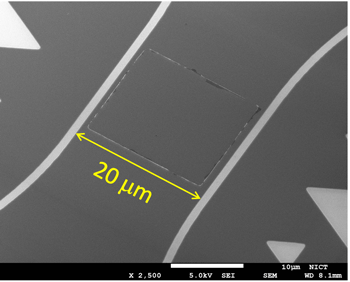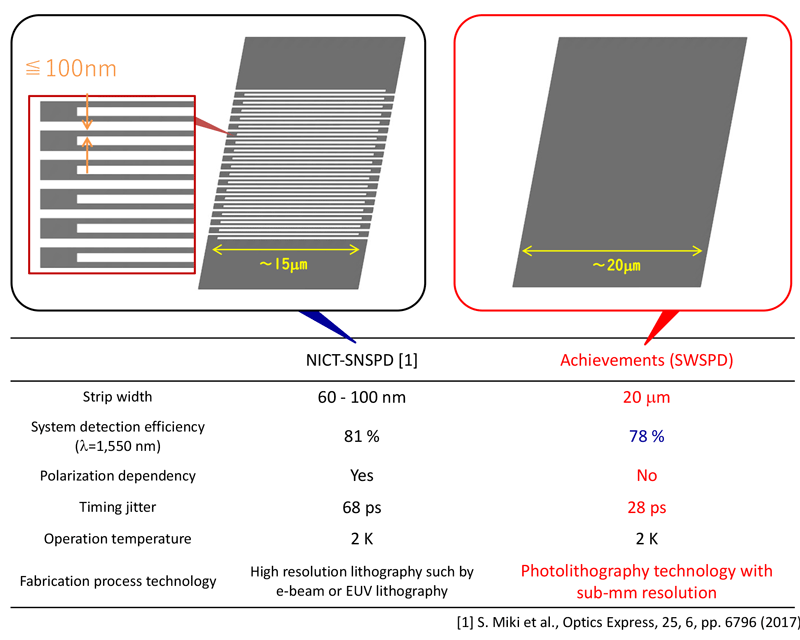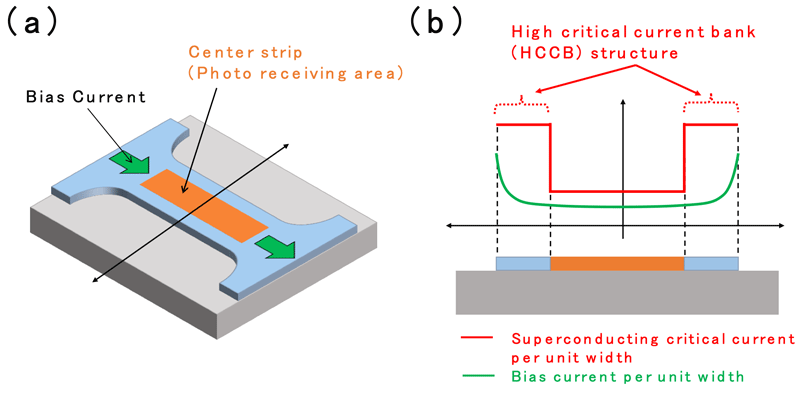Highlights
-
Succeeded in developing a “Superconducting Wide-Strip Photon Detector” with a superconducting strip over 200 times wider than the conventional nanostrip
-
Achieves high productivity and polarization independence while maintaining high detection efficiency comparable to that of the nanostrip type
-
Lowering the fabrication cost and hurdles of photon detectors, accelerating the realization of quantum information communication and quantum computers
The National Institute of Information and Communications Technology (NICT, President: TOKUDA Hideyuki, Ph.D.) invented a novel structure in a superconducting strip photon detector that enables highly efficient photon detection even with a wide strip, and succeeded in developing the world's first “Superconducting Wide-Strip Photon Detector (SWSPD)”.
The strip width of the detector is over 200 times wider than that of the conventional Superconducting NanoStrip Photon Detectors (SNSPDs). With this technology, we can solve the problems of low productivity and polarization dependence which have been in the conventional SNSPDs. Our new SWSPD is expected to be applied into various advanced technologies such as quantum information communication and quantum computers, enabling early social implementation of these advanced technologies.
This result was published in the US scientific journal “Optica Quantum” on Thursday, October 26, 2023.
Background

Figure 1 Developed Superconducting Wide-Strip Photon Detector (SWSPD)
Photon detection technology is a strategic core technology to bring about an innovation in a wide range of advanced technology fields such as not only quantum information communication and quantum computing which are currently undergoing intense research and development on a global scale, but also live cell fluorescent observation, deep space optical communication, laser sensing, and so on. NICT has been developing a SNSPD with a strip width of 100 nm or less. As results, we have successfully achieved high performance surpassing other photon detectors, and have demonstrated its usefulness by applying it to quantum information communication technology. However, the fabrication of SNSPDs requires the formation of nanostrip structures using advanced nanofabrication technology, which causes variations in detector performance and hinders productivity improvement. In addition, the presence of polarization dependence due to the superconducting nanostrip meandering structure has also limited the application range as a photon detector.
Achievements
In this work, NICT invented a novel structure called “High Critical Current Bank (HCCB) structure” that enables highly efficient photon detection even if the strip width is widened in the superconducting strip photon detector, and succeeded in developing a SWSPD with a width of 20 micrometers (see Figure 1), which is over 200 times wider than the conventional nanostrip photon detector, and achieved high-performance operation for the first time in the world.
As shown in Figure 2, the nanostrip type, which has been developed by NICT, required the formation of extremely long superconducting nanostrips with a strip width of 100 nm or less in a meandering shape. The wide strip type can now be formed with only single short straight superconducting strip.
This SWSPD does not require nanofabrication technology and can be fabricated by highly productive general-purpose photolithography technology. In addition, since the strip width is wider than the incident light spot irradiated from the optical fiber, it is possible to eliminate the polarization dependence seen in the nanostrip type detector. As a result of performance evaluation of this detector, the detection efficiency in the telecommunication wavelength band (λ=1,550 nm) was 78%, which is comparable to the 81% of the nanostrip type. Furthermore, the timing jitter showed better numerical values than the nanostrip type (see Figure 2).

Figure 2 Comparison of structure and performance between conventional technology (Superconducting NanoStrip Photon Detector (SNSPD)) and newly developed technology (Superconducting Wide-Strip Photon Detector (SWSPD))
Future prospects
This achievement enables the fabrication of photon detectors with higher productivity and superior performance and features compared to the nanostrip type which has been positioned as an indispensable photon detection technology in advanced technology fields such as quantum information communication. Such technology is expected to be applied to various quantum information communication technologies and to be an important basic technology for realizing networked quantum computers promoted in JST Moonshot Goal 6.
In the future, we will further explore the HCCB structure in the SWSPD, to detect photons with high efficiency not only in the telecommunication wavelength band but also in a wide wavelength band from the visible to the mid-infrared. Furthermore, we will also try further expansion of the size of the photon receiving area for expanding the applications such as deep space optical communication technology, laser sensing, live cell observation and so on.
References
Journal: Optica Quantum
DOI: 10.1364/OPTICAQ.497675
URL: https://doi.org/10.1364/OPTICAQ.497675
Title: Superconducting wide strip photon detector with high critical current bank structure
Authors: Masahiro Yabuno, Fumihiro China, Hirotaka Terai and Shigehito Miki
Part of this work was supported by Japan Science and Technology Agency (JPMJMS2066), and Japan Society for the Promotion of Science (22H01965).
DOI: 10.1364/OPTICAQ.497675
URL: https://doi.org/10.1364/OPTICAQ.497675
Title: Superconducting wide strip photon detector with high critical current bank structure
Authors: Masahiro Yabuno, Fumihiro China, Hirotaka Terai and Shigehito Miki
Part of this work was supported by Japan Science and Technology Agency (JPMJMS2066), and Japan Society for the Promotion of Science (22H01965).

 nict.go.jpa
nict.go.jpa